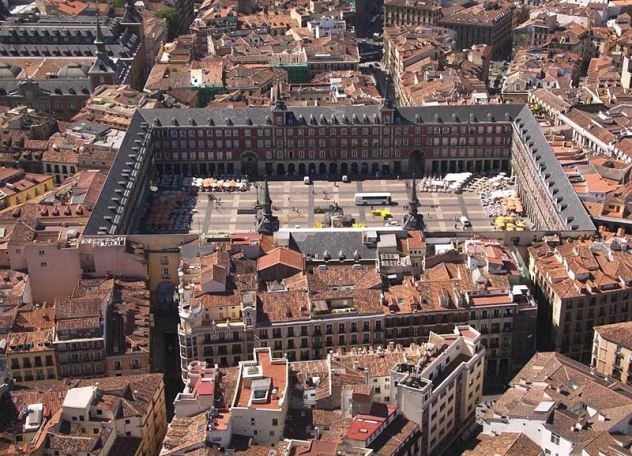

Plaza Mayor is the main city square in Madrid. It is a rectangular open space in a part of town, which is traditionally called "the Austrian Madrid". In the Middle Ages it was located outside of Madrid city walls, and therefore it was called Arrabal, which can be translated as a "suburb". Plaza Mayor was formed in the Middle Ages at the junction of two roads Toledo and Atocha. A market naturally grew here and over time it became one of the most important markets of Madrid. During reign of king Philip III it was reconstructed to give it more appeasing look and on May 15, 1620 the ceremony of the inauguration of new Plaza Mayor was held here. The opening was timed to coincide with the date sanctification of Isidro de Merlo and Quintana. It was the first ceremony that took place on Madrid Plaza Mayor and continued for eight days. Residents of Madrid celebrate May 15 as a commemoration day of Saint Isidro, patron saint of the city. Most of celebrations are held at Plaza Mayor. Today this square lost its role as a market, but its still attracts thousands of tourists who flock to the historic part of the city to enjoy cozy cafes and restaurants that line sides of plaza.
The name of the square has varied throughout
history, from the original name of "Plaza del Arrabal" it was
renamed "Plaza Mayor".
It was called "Plaza del Arrabal" when, being outside the medieval
walled enclosure, it became the center of the new neighborhoods
formed by the widening of the town to the east during the reign of
Juan II of Castile, called «el Arrabal» .
In 1812, fulfilling the decree that all the major squares of Spain
were to be called "Plaza de la Constitución", it changed its name,
but only lasted until 1814, when it was renamed "Plaza Real". It
recovered the name of "place of the Constitution" in the periods of
1820 to 1823, of 1833 to 1835 and of 1840 to 1843.
In 1873, it changed its name to "Plaza de la República" and again to
"Plaza de la Constitución" from the Restoration of Alfonso XII in
1876 until the dictatorship of Primo de Rivera in 1923. After the
proclamation of the II Republic was changed again to the name of
"Plaza de la Constitución" until the end of the Spanish Civil War
when the popular name of "Plaza Mayor" was recovered, a name that
lasts until today.
The Plaza Mayor became since its inception, not
only in the main market of the town, both supply (stocked by
numerous tablajeros monitored by the Repeso ) and other genres
(settling in arcades major guilds); but also on the stage of
numerous public events, such as bullfights , autos de fe ,
immortalizing the painter Francisco Rizi the celebrated in 1680,
public executions, placing the scaffold in front of the draper's
portal if the penalty was garrote; in front of the House of the
Bakery, if it was hanging, and before the House of the Carnage, if
it was a knife or ax. The Beatification of San Isidro was also
celebrated in the Plaza Mayor, patron saint of Madrid.
The Plaza Mayor is currently an important tourist spot, visited by
thousands of tourists a year. In the commercial premises located
under the arcades, the shops of catering trade abound, that install
terraces next to the arcades of the place. It is also a space widely
used for festivals, such as concerts that are offered free of charge
to the locals during the fiestas of San Isidro. All the months of
December, the traditional Christmas market is celebrated, a custom
that has been in force since 1860. It is also installed every Sunday
and holidays in the morning the philately and numismatic market .
There is a bronze statue of King Philip III at the center of the square, created in 1616 by Jean Boulogne and Pietro Tacca. Giambologna's equestrian statue of Philip III dates to 1616, but it was not placed in the center of the square until 1848. The statue was a gift from the Duke of Florence at that time. It was Queen Isabel II ordered to move it from Casa de Campo to become the centerpiece of the Plaza Mayor.